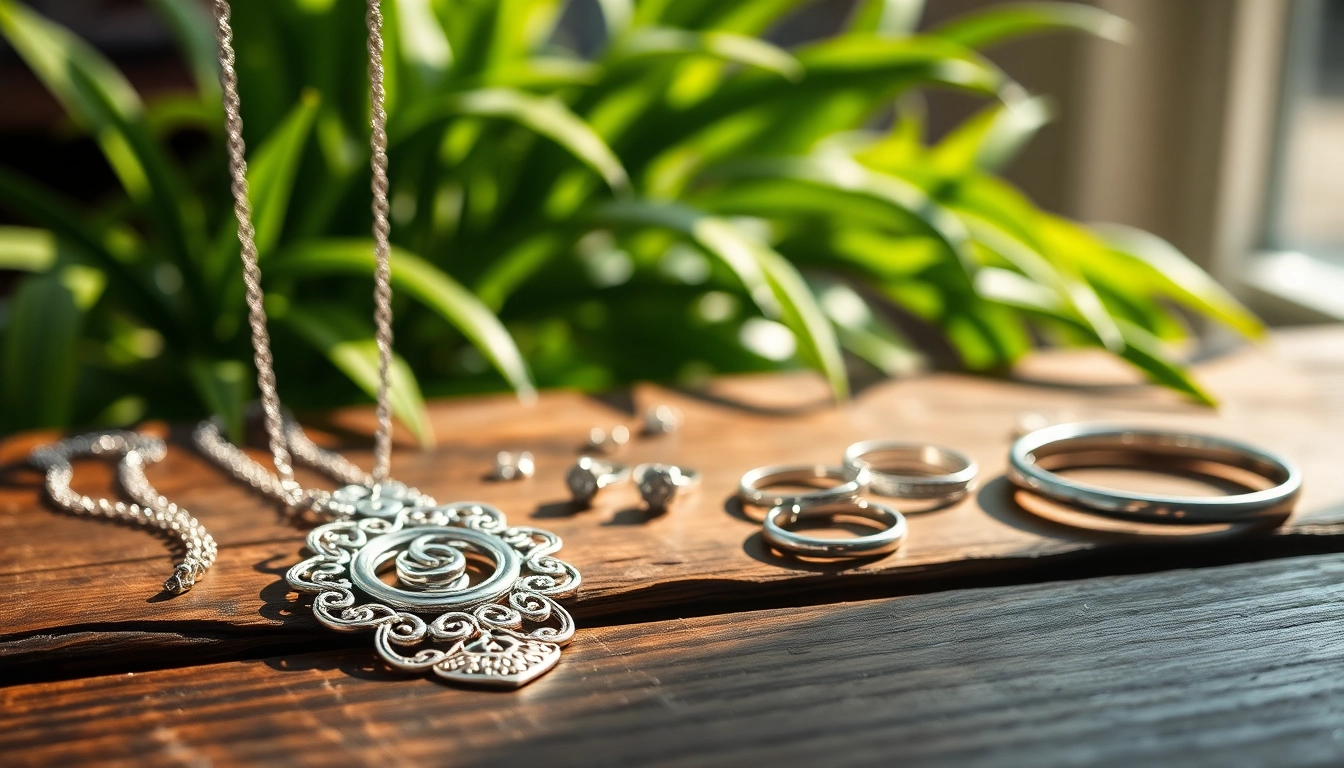The Rich History of Silver Jewelry
Silver jewelry has captivated humans for centuries, serving not only as a means of adornment but also as an expression of culture, status, and artistry. From ancient civilizations to modern designs, the allure of silver continues to evolve. Its historical significance is beautifully intertwined with cultural narratives, craftsmanship, and innovations. As we dive into this topic, we will explore the rich history of silver jewelry that speaks to its timeless elegance and enduring charm.
Origin and Cultural Significance
The origins of silver jewelry can be traced back to ancient civilizations, where it was highly valued for its beauty and rarity. In Ancient Egypt, silver was seen as a symbol of wealth and power, often utilized in royal ornaments. The Greeks and Romans also revered silver, producing intricate designs that showcased their skills in metalwork.
In various cultures, silver has been associated with the moon, often reflecting the light in ways that create a magical allure. Differentiating silver jewelry from gold, many cultures believe silver has protective properties. For instance, in Indigenous cultures of the Americas, silver is often used in ceremonial items believed to bring luck and health.
Materials and Craftsmanship
Craftsmanship in silver jewelry showcases the artistry of metalsmiths who manipulate the material into artistic expressions. To create exquisite pieces, artisans use various techniques such as casting, forging, and engraving. Many regions have distinguished styles that incorporate their unique cultural elements. For example, Mexican silversmiths are known for their intricate filigree work, while Scandinavian designs often celebrate minimalism.
The craftsmanship often utilizes sterling silver, which comprises 92.5% silver mixed with other metals to enhance durability. Understanding these materials is crucial for both makers and consumers, as it determines not only the quality but the type of designs achievable.
Evolution of Styles Over Time
From ancient designs to contemporary pieces, the evolution of silver jewelry styles reflects broader societal changes. The Victorian era popularized ornate designs, while the Art Deco movement celebrated geometry and streamlined forms, all crafted from silver. In the 20th century, silver jewelry became accessible to the masses, leading to the rise of unique fashion statements.
Contemporary trends have seen a resurgence of minimalist designs that celebrate silver’s natural sheen, incorporating modern elements with vintage inspiration. Designers are blending traditional techniques with modern aesthetics, breathing new life into this historic material.
Types of Silver Jewelry
Silver jewelry comes in various forms, each serving a different purpose and appeal. Understanding these types can help consumers make informed choices when selecting pieces that resonate with their personal style.
Rings: Statement Pieces vs. Everyday Wear
Rings are perhaps one of the most personal types of jewelry. They can denote engagement, commitment, or simply be a fashion statement. Statement rings, characterized by bold designs and larger gemstones, command attention and are often worn for special occasions.
On the other hand, everyday rings tend to be more subdued, prioritizing comfort and versatility. These pieces often feature simple bands or smaller stones, suitable for daily wear or stacking with other rings. The balance between statement and simplicity makes rings a universally loved form of silver jewelry.
Necklaces: From Simple Chains to Intricate Designs
Silver necklaces range from delicate chains to elaborate pendant designs. Simple chains can be worn alone for an understated look or adorned with pendants to express individuality. Intricate designs often highlight artisanal craftsmanship, incorporating techniques such as engraving or enameling.
Layering necklaces has become a popular trend, allowing wearers to mix and match different styles and lengths, creating a unique personal statement. With options from minimalist to extravagant, silver necklaces cater to diverse tastes and occasions.
Earrings: Dangles, Hoops, and Studs
Silver earrings come in various styles, each adding distinct character to one’s appearance. Studs are often chosen for their simplicity and elegance, making them ideal for both professional settings and casual outings. Dangles and hoops, in contrast, provide a bolder aesthetic that can elevate an outfit while allowing for personalization.
The versatility of silver earrings is unmatched, with options that can be dressed up or down depending on the occasion. Experimenting with styles and dimensions can lead to limitless combinations, whether it’s stacking or singularly showcasing a unique design.
Choosing Quality Silver Jewelry
When purchasing silver jewelry, understanding quality is crucial. Not all silver is created equal, and distinguishing between high-quality pieces and lesser alternatives can significantly affect the value and satisfaction of your investment.
Understanding Silver Purity: Sterling vs. Other Alloys
Silver purity is often denoted in terms of parts per thousand. Sterling silver, for instance, contains 92.5% silver—designated as .925—mixed with other metals like copper to improve strength. Knowing the difference is essential as it can affect how the jewelry wears over time and its overall luster.
Other alloys, like “coin silver,” which historically contained 90% silver, may be marketed differently, so it’s important to ask for certifications or stamps denoting silver content when buying. This knowledge empowers consumers to make informed choices and ensures they’re investing in quality.
Recognizing Authenticity and Craftsmanship
Beyond purity, recognizing authentic craftsmanship is vital in selecting silver jewelry. Look for details that showcase attention to artistry, such as intricate engravings or unique finishes. Reputable jewelers will provide information on the origin of their pieces, and many artisan-crafted items will be stamped or tagged with the creator’s mark.
Additionally, seeking out certifications can help in verifying quality. Some artisans may offer guarantees on their work, enhancing confidence in the purchase. Taking time to research brands or individual craftsmen can significantly enrich your experience as a buyer.
Care Tips for Longevity
Proper care and maintenance can prolong the life of silver jewelry and maintain its brilliance. Silver naturally tarnishes when exposed to air and moisture. Regular cleaning and storage can prevent this phenomenon. Use a soft cloth to gently buff silver pieces, focused on areas that exhibit tarnishing.
It’s advisable to store silver in a cool, dry place, ideally in an anti-tarnish pouch, and to avoid contact with chemicals, including lotions and perfumes that can accelerate tarnishing. Regular care ensures the jewelry remains a cherished part of your collection for years to come.
Styling Silver Jewelry
Styling silver jewelry effectively can enhance any outfit and elevate personal style. Understanding how to mix and match pieces creates endless possibilities for expression.
Mixing with Other Metals and Gemstones
The beauty of silver jewelry lies in its versatility. Mixing silver with gold or rose gold pieces can create visually interesting contrasts that highlight both materials’ unique properties. Specific color palettes can also be used to harmonize various metallic tones.
Incorporating gemstones, whether in rings, earrings, or necklaces, can also enhance silver’s appeal. Stones like turquoise, lapis lazuli, or even diamonds can add color and sparkle, enabling wearers to express their personality through thoughtful combinations.
Accessorizing for Different Occasions
Silver jewelry can be styled for various occasions, from casual events to formal gatherings. For casual outfits, simple pieces like stud earrings or a delicate pendant can provide a polished look without overwhelming the ensemble.
For formal occasions, statement pieces that draw attention, such as bold necklaces or oversized rings, can make a strong statement, accentuating elegance. Understanding the context of an occasion ensures that your jewelry complements instead of conflicts with your overall appearance.
Creating Unique Looks: Layering Techniques
Layering jewelry has become a fashionable approach to crafting unique looks. By combining different lengths and styles of necklaces, for instance, wearers can create a personalized statement. Similarly, stacking rings allows individuals to showcase their creativity and style.
When layering, consider contrasting textures or finishes for visual interest. Mixing polished pieces with oxidized silver can create depth, while varying the use of gemstones can introduce exciting elements to the overall look. The key is to maintain balance, ensuring no single item outshines the others excessively.
The Future of Silver Jewelry
The future of silver jewelry is poised for innovative transformations, with sustainability, ethical sourcing, and personalization taking center stage.
Sustainability and Ethical Sourcing
As consumers become more environmentally conscious, the demand for sustainably sourced silver has surged. Many jewelry makers are beginning to adopt eco-friendly practices, utilizing recycled silver to reduce the need for mining, which significantly impacts the planet.
Incorporating sustainable practices not only appeals to eco-aware consumers but also sparks conversations about responsible sourcing and fair labor practices in metallurgy. Consumers are encouraged to inquire about a brand’s sourcing methods to align their purchases with personal beliefs regarding sustainability.
Trends to Watch in Silver Jewelry Design
Emerging trends in silver jewelry design are focusing on minimalism, combined with bold experimentation. As local artisans gain recognition, we see a rise in handcrafted pieces featuring intricate details that resonate with a contemporary audience.
Also noteworthy is the incorporation of technology in design processes, allowing for unique 3D-printed or digitally rendered pieces that push the boundaries of traditional craftsmanship. These trends signal a vibrant future for silver jewelry as it blends time-honored techniques with modern innovation.
Personalization and Customization Options
The desire for personalized jewelry continues to grow. Customized pieces that reflect individual styles or commemorate specific moments in life create lasting connections and sentimental value.
Jewelry designers are increasingly offering services where customers can choose elements of a piece, from the type of silver used to the addition of personalized engravings or gemstones. This level of customization enhances the emotional significance of the jewelry, turning each item into a unique treasure.



